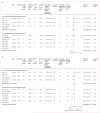Women's groups practising participatory learning and action to improve maternal and newborn health in low-resource settings: a systematic review and meta-analysis
- PMID: 23683640
- PMCID: PMC3797417
- DOI: 10.1016/S0140-6736(13)60685-6
Women's groups practising participatory learning and action to improve maternal and newborn health in low-resource settings: a systematic review and meta-analysis
Erratum in
- Lancet. 2014 May 24;383(9931):1806
Abstract
Background: Maternal and neonatal mortality rates remain high in many low-income and middle-income countries. Different approaches for the improvement of birth outcomes have been used in community-based interventions, with heterogeneous effects on survival. We assessed the effects of women's groups practising participatory learning and action, compared with usual care, on birth outcomes in low-resource settings.
Methods: We did a systematic review and meta-analysis of randomised controlled trials undertaken in Bangladesh, India, Malawi, and Nepal in which the effects of women's groups practising participatory learning and action were assessed to identify population-level predictors of effect on maternal mortality, neonatal mortality, and stillbirths. We also reviewed the cost-effectiveness of the women's group intervention and estimated its potential effect at scale in Countdown countries.
Findings: Seven trials (119,428 births) met the inclusion criteria. Meta-analyses of all trials showed that exposure to women's groups was associated with a 37% reduction in maternal mortality (odds ratio 0.63, 95% CI 0.32-0.94), a 23% reduction in neonatal mortality (0.77, 0.65-0.90), and a 9% non-significant reduction in stillbirths (0.91, 0.79-1.03), with high heterogeneity for maternal (I(2)=58.8%, p=0.024) and neonatal results (I(2)=64.7%, p=0.009). In the meta-regression analyses, the proportion of pregnant women in groups was linearly associated with reduction in both maternal and neonatal mortality (p=0.026 and p=0.011, respectively). A subgroup analysis of the four studies in which at least 30% of pregnant women participated in groups showed a 55% reduction in maternal mortality (0.45, 0.17-0.73) and a 33% reduction in neonatal mortality (0.67, 0.59-0.74). The intervention was cost effective by WHO standards and could save an estimated 283,000 newborn infants and 41,100 mothers per year if implemented in rural areas of 74 Countdown countries.
Interpretation: With the participation of at least a third of pregnant women and adequate population coverage, women's groups practising participatory learning and action are a cost-effective strategy to improve maternal and neonatal survival in low-resource settings.
Funding: Wellcome Trust, Ammalife, and National Institute for Health Research Collaboration for Leadership in Applied Health Research and Care for Birmingham and the Black Country programme.
Copyright © 2013 Elsevier Ltd. All rights reserved.
Figures




Comment in
-
Participatory women's groups: ready for prime time?Lancet. 2013 May 18;381(9879):1693-4. doi: 10.1016/S0140-6736(13)61029-6. Lancet. 2013. PMID: 23683618 No abstract available.
-
Can women's groups reduce maternal and newborn deaths?Lancet. 2013 May 18;381(9879):e12-4. doi: 10.1016/S0140-6736(13)60985-X. Lancet. 2013. PMID: 23683647 No abstract available.
-
Analyses confirm effect of women's groups on maternal and newborn deaths.Lancet. 2013 May 18;381(9879):e15. doi: 10.1016/S0140-6736(13)61082-X. Lancet. 2013. PMID: 23683648 No abstract available.
-
Trials of participation to improve maternal and newborn health.Lancet. 2013 Aug 24;382(9893):681. doi: 10.1016/S0140-6736(13)61771-7. Lancet. 2013. PMID: 23972806 No abstract available.
-
Trials of participation to improve maternal and newborn health - Authors' reply.Lancet. 2013 Aug 24;382(9893):681-2. doi: 10.1016/S0140-6736(13)61772-9. Lancet. 2013. PMID: 23972807 No abstract available.
References
-
- WHO. UNICEF [accessed Feb 8, 2013];Countdown 2015: building a future for women and children, the 2012 report. http://countdown2015mnch.org/documents/2012Report/2012-Complete.pdf.
-
- Lozano R, Wang H, Foreman KJ, et al. Progress towards Millennium Development Goals 4 and 5 on maternal and child mortality: an updated systematic analysis. Lancet. 2011;378:1139–65. - PubMed
-
- UNICEF . Levels and trends in child mortality: estimates developed by the UN Inter-agency Group for Child Mortality Estimation. UNICEF; New York: [accessed Feb 8, 2013]. 2012. http://www.childinfo.org/files/Child_Mortality_Report_2012.pdf.
-
- Darmstadt GL, Bhutta ZA, Cousens S, Adam T, Walker N, de Bernis L, for the Lancet Neonatal Survival Steering Team Evidence-based, cost-effective interventions: how many newborn babies can we save? Lancet. 2005;365:977–88. - PubMed
-
- Lassi ZS, Haider BA, Bhutta ZA. Community-based intervention packages for reducing maternal and neonatal morbidity and mortality and improving neonatal outcomes. Cochrane Database Syst Rev. 2010;11:CD007754. - PubMed
Publication types
MeSH terms
Grants and funding
LinkOut - more resources
Full Text Sources
Other Literature Sources
Medical
Miscellaneous

